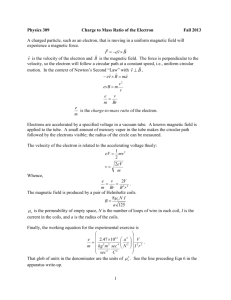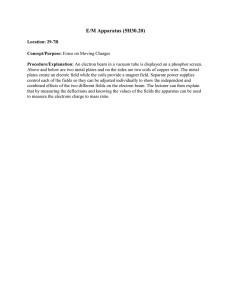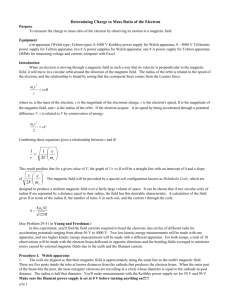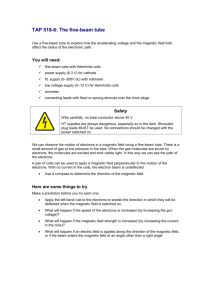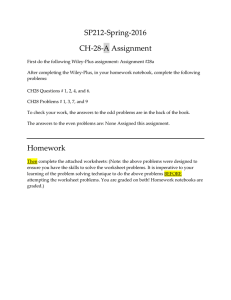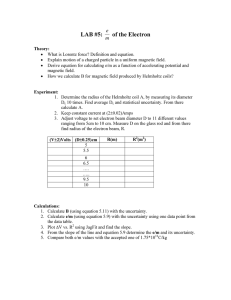Electron Charge-to-Mass Ratio Lab: Physics Experiment
advertisement
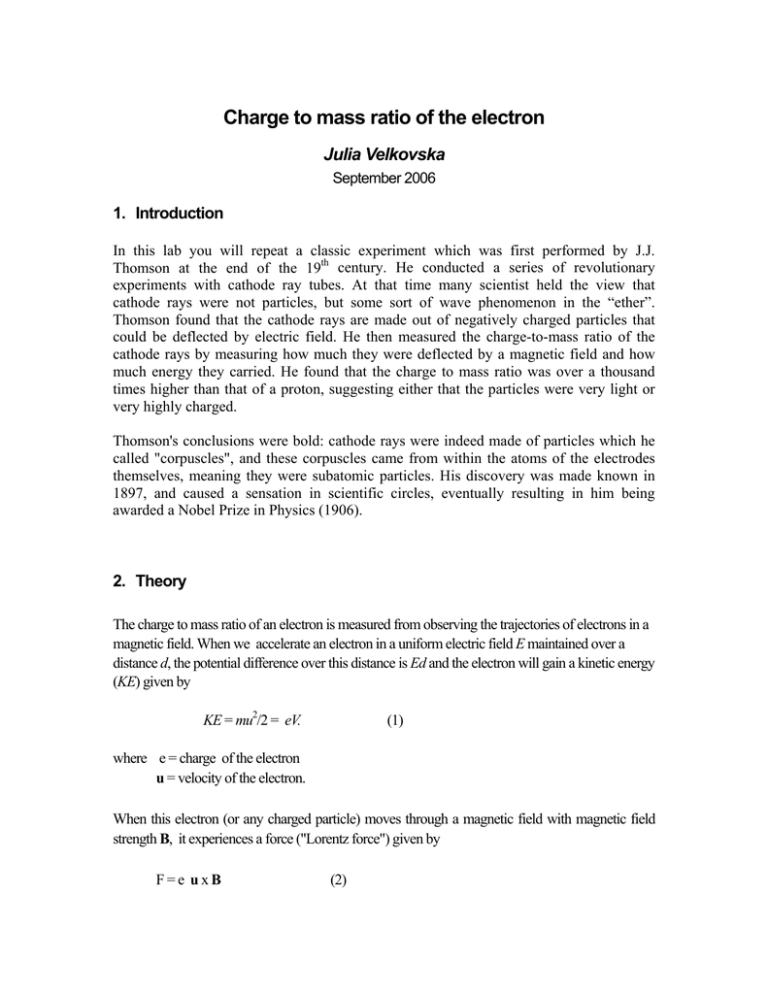
Charge to mass ratio of the electron Julia Velkovska September 2006 1. Introduction In this lab you will repeat a classic experiment which was first performed by J.J. Thomson at the end of the 19th century. He conducted a series of revolutionary experiments with cathode ray tubes. At that time many scientist held the view that cathode rays were not particles, but some sort of wave phenomenon in the “ether”. Thomson found that the cathode rays are made out of negatively charged particles that could be deflected by electric field. He then measured the charge-to-mass ratio of the cathode rays by measuring how much they were deflected by a magnetic field and how much energy they carried. He found that the charge to mass ratio was over a thousand times higher than that of a proton, suggesting either that the particles were very light or very highly charged. Thomson's conclusions were bold: cathode rays were indeed made of particles which he called "corpuscles", and these corpuscles came from within the atoms of the electrodes themselves, meaning they were subatomic particles. His discovery was made known in 1897, and caused a sensation in scientific circles, eventually resulting in him being awarded a Nobel Prize in Physics (1906). 2. Theory The charge to mass ratio of an electron is measured from observing the trajectories of electrons in a magnetic field. When we accelerate an electron in a uniform electric field E maintained over a distance d, the potential difference over this distance is Ed and the electron will gain a kinetic energy (KE) given by KE = mu2/2 = eV. (1) where e = charge of the electron u = velocity of the electron. When this electron (or any charged particle) moves through a magnetic field with magnetic field strength B, it experiences a force ("Lorentz force") given by F=e uxB (2) If B is perpendicular to u then the electron will move in a circle whose plane is also perpendicular to B, and the magnetic force (Lorentz force) provides the centripetal force for this circular motion, i.e. mu2/r = euB (3) where m = mass of electron r = radius of circular path. Solve Eq. (3) for u and substitute into Eq. (1) to obtain an expression for the charge-to-mass ratio of the electron e/m = 2V / (Br)2 (4) So if we know the magnitude of the magnetic field, the potential difference V and the radius of the path r, we can calculate the charge-to-mass ratio of the electron. For electrons (or any given kind of particle) the left hand side is a constant. For example, if we raise the energy of the electrons injected into the magnetic field region (by increasing the accelerating potential V) , and we desire to maintain an orbit with the same radius, then we would have to increase the magnitude of the magnetic field. Alternatively, if we want to increase the radius of the circular orbit we would have to decrease the magnitude of the magnetic field. 3. Experimental apparatus Helmholtz coils e/m tube 2 Low-voltage power supplies DC PRECISION1623A supply 2 Digital multimeter 1 Digital multimeter Digital multimeter Magnetic dip needle Banana-plug test leads Welch No. 0623A Welch No. 0623 GW GPS 1850 ( 0-18 V, 0-5 A) 0-60 V, 10 A sensitivity 200 µA sensitivity (voltmeter) A picture of the experimental apparatus is shown below. Figure 1 Helmholtz coils and e/m vacuum tube used in this experiment. Electron beam tube: The beam of electrons in the tube is produced by an electron gun composed of a straight filament surrounded by a coaxial anode containing a single axial slit. See Fig. 2 for a schematic diagram of the tube. The electrons are generated by heating a filament F. Heating gives some of the electrons in the filament enough energy to overcome the surface barrier and escape from the metal. These electrons are then accelerated by a potential applied between the filament (the cathode) and the anode C. Some of the electrons come out as a narrow beam through the slit S in the side of C. When electrons of sufficiently high kinetic energy (10.4 electron volts or more) collide with mercury atoms, mercury vapor being present in the tube, a fraction of the atoms will be ionized. On recombination of these ions with stray electrons the mercuryarc spectrum is emitted with its characteristic blue color. Since recombination with emission of light occurs very near the point where ionization took place, the path of the beam of electrons is visible as the electrons travel through the mercury vapor. Figure 2 A sectional view of the tube and filament assembly (left) and (right) - a detailed section of the filament assembly (rotated 90o ) . A: Five cross bars (posts) attached to staff wire. B: Typical path of beam of electrons. C: Cylindrical anode. D: Distance from filament to far side of each of the cross bars. E: Lead wire and support for anode. F: Filament. G: Lead wires and supports for filament. L: Insulating plugs. S: Slit in cylindrical anode. Five crossbars have been attached to the staff wire and this assembly attached to the filament assembly in precise fixtures which accurately control the distances between the crossbars and the filament. The distances between these posts and the filament are supplied with the tube. To the far side of the posts from the filament, they are given in Table 1. Table 1 Location of measurement posts. Post Number 1 2 3 4 5 Distance [m] 0.065 0.078 0.090 0.103 0.115 In order to perform this experiment we must know r, V, and B. We have just been given r, and V is a simply applied and measured potential from a variable power supply. How do we establish and measure B? Helmoltz cols: We employ a uniquely useful arrangement of conductors called Helmholtz coils. They are a pair of thin, hoop-like coils which assume very special qualities when positioned on a common axis and spaced a distance equal, to one-half their common diameter. If one connects them in series -- and in the same polarity -- and passes current through them, the result is a magnetic field near the center of this array which is exceedingly homogeneous over a fairly large volume. For those who might be motivated to try it, the calculation of the field on the axis (through the use of the Biot-Savart law) is not hard. You can even prove the virtues of the half-diameter spacing by computing the central field for some general spacing x, and finding x for which the second derivative of Bz with respect to z vanishes. We won't require any of that here, however. Without deriving the result, we will simply give the formula which gives B ( in Tesla). Β= 8µ0 ΝΙ a 125 where: N = number of turns in each coil, I = current through the coils in amperes, a = radius of coils in meters, and µo = permeability of free space ( 4π x 10-7 T.m/A) For our set-up (model Welch N0. 0623A), N = 72 and a = 0.33 m. The coils are supported in a frame which can be adjusted with reference to the dip angle so that their magnetic field will be parallel to the earth’s magnetic field but oppositely directed. A safety device prevents the coils from accidentally dropping back to the horizontal. Wooden scats with retaining straps cradle the tube in a central plane midway between the two coils. 4. Experimental procedure 4.1. Setting up the coils. Before you start the measurement you need to take care of the fact that the Earth’s magnetic field will influence the trajectory of the electrons. We can not turn off the Earth’s magnetic field, but we could set-up the apparatus in such a way that will allow us to account for it. Using the dip needle determine the direction of the earth's field, and then adjusting the coil axis to be along this direction. Do this is two steps: First orient the Helmholtz Coils so that the e/m tube will have its long axis in a magnetic north-south direction. Then put the dip needle vertically and measure the magnetic inclination at this location. Raise the North end of the coils so that the axis of the coils is parallel to the geomagnetic field. Connect one of the GPS 1850 ( 0-18 V, 0-5 A) power supplies, the Helmholtz coils and the 10A ammeter as shown in Figure 3. NOTE: an ammeter should ALWAYS be connected in series with the voltage source! DO NOT turn the power supply on yet. There are two knobs – one controlling the voltage and one regulating the current. Turn both of these to zero (all the way to the left). Ask your instructor to explain to you how this power supplies work. Figure 3 Connections for the Helmholtz coils. 4.2. The filament circuit and accelerating voltage. These components are to be connected according to the diagram of Fig. 4. This year, we have a different model power supplies than indicated in the figure, but they do the same job. We use the DC PRECISION 1623A to supply an accelerating potential between one side of the filament F2 and the anode A. The GPS 1850 ( 0-18 V, 0-5 A) supply is used to supply the filament current ( between F1 and F2). Connect a 10A ammeter in series with the filament. You will need to control this current carefully and keep it below 4.5A ! Exceeding this current will shorten the tube’s life. Before pushing the ON button of any power supply, turn both voltage and current knobs to zero. Also, when you want to turn the supply off, first reduce the current to zero using the current-limit knob and then push the OFF button. This will minimize power surges in the filament. ASK YOUR INSTRUCTOR TO CHECK YOUR CIRCUIT BEFORE GOING ON. Figure 4 Circuit diagram for the filament current and accelerating potential. The filament of the e/m tube has the proper electron emission when carrying 3.8 – 4.5 amperes. Good results can be obtained using an accelerating voltage of 22½ to 45 volts. An electron emission current of about 2 to 4 mA gives a visible beam. For maximum filament life operate the tube with the minimum filament current necessary for proper electron emission. • • Turn on the accelerating potential power supply. Increase the voltage to 25 V. Next, turn on the filament power supply. Turn the fine current adjustment a tiny bit up, then increase the voltage to 3 V and don’t touch this knob any more. You can now increase the current by turning the current regulating knob. Carefully increase the current to 3.8 A. Then darken the room. The filament will take a few minutes to heat up. First you will see and orange glow through the slit and then you should see the blue beam of electrons (as in the picture below). Figure 5 The electron beam hitting the glass tube. 5. Measuring e/m 5.1. In the absence of magnetic and electric fields, the electron will travel in a straight path. The Earth's field, however, will bend the beam toward the back of the tube. Turn on the Helmoltz coils power supply and turn up the current until the beam is straight. You can tell the beam is straight when the electron beam is in the center of the light streak that the filament shines on the side of the rube. Record the current in the coils. You will need this current to correct your measurements of B. Estimate the uncertainty in your measurement of the current. 5.2. Continue to increase the coil current until the outside of the electron beam hits the outside of the outermost peg. The best viewing position is directly above the tube. Record the filament current, the magnet current, the beam current, and the accelerating voltage. Repeat the procedure for the inner pegs. 5.3. Repeat the determination of e/m for accelerating potentials of 30 V and 40V. 5.4. Finishing up. Turn the filament current down to zero. Turn down the accelerating voltage. Turn off all power supplies, and disconnect the electron tube from the other circuitry. 6. Data analysis 6.1. Every set of the coil current (and thus magnetic field), accelerating voltage and orbit radius provides an independent measurement of e/m. Make sure that you correct for the Earth’s magnetic field. 6.2. Estimate the uncertainties on your measurements of the directly measured quantities V, I, and r (assume that a is a constant), and from these determine an uncertainty for every individual measurement of e/m. Take the average of all of measurements of e/m values and determine the standard deviation. Compare the average of the individual uncertainties with the standard deviation. 6.3. Compare your results for e/m with the accepted value. Do they agree within experimental uncertainties? 6.4. How high an accelerating voltage would be required before relativistic effects increase the observed mass by 1 %? 7. References 7.1. Welch Scientific Co., Instruction for Use of e/m Tube and Helmholtz coils, Chicago. 7.2. Prof. Webster’s lab write-up http://www.hep.vanderbilt.edu/~webster/classes/p225lab/ebym.pdf
